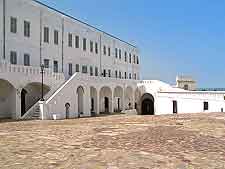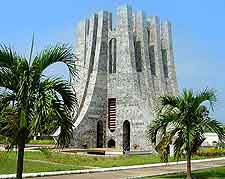Ghana History Facts and Timeline
(Ghana, GH, Western Africa)

Known for its lengthy coast, gold and slave trade, Ghana has a recent recorded history mostly involving colonialism and independence. Humans lived in this African country from 1500 BC, although there is no relation with the people of today.
The Dagombas (first on the scene), along with the Akan, the Ga and the Ewe, made their appearance during the 13th century, while the Ghana of today encompasses the formerly influential Ashanti Empire.
Early Times and Colonialism
As with much of West Africa, the Portuguese were the first Europeans to land in Ghana, in the 15th century, and came looking for gold. The Dutch were also here by the mid-1500s, erecting fortifications at Kormantsi and Komenda, followed by the Danish, the English, the French and the Swedish in the 17th century.
British merchants named it the Gold Coast, while the French named the nearby Ivory Coast (Côte d'Ivoire) on account of the natives' love of ivory trinkets. Accra, founded in the 16th century by the Ga people, came about around this time in earnest. Over the years it has been held by the Dutch, the Danes and the English, and eventually became the capital in the middle of the 20th century. Tourists come to see the Danish Osu Castle, among other fine landmarks based within this African capital.
History of the Slave Trade
Castles (slave forts) along the Cape Coast date from this time, while nearby Elmina Castle (standing on the Ivory Coast) hails from the 15th century and offers guided tours, which recount the story of the slave trade and colonial times in Ghana history.
The Pikworo Slave Camp (from the early 1800s) in Bolgatanga was home to many slaves in the north, while the inland city of Kumasi - home of the Ashanti Kingdom and Ghanaian culture, also rose at this time, in the year of 1695. Tours around the king's palace grounds are especially popular.

British Protectorate and Independence
The Dutch left Ghana in 1874, after which the Gold Coast (most of historic Ghana) became a British protectorate. Things were not rosy at this time between the colonial powers of West Africa and the natives, and there were many wars and revolts.
Ghana gained its independence in 1957, following years of strife post-WWII. Kwame Nkrumah declared his country independent, one of the first to set off the 'winds of change' through British colonial Africa. This event is marked in Accra by its Independence Arch (similar to the Arc de Triomphe in
Paris), which now serves as one of the capital's main landmarks.
Tourists started to come to Ghana to see the coast and Accra, as well as to venture into the countryside. The Kakum National Park was established in 1960 and is one of Ghana's main attractions today, with high ropeways amid the rainforest canopy. The Mole National Park, near Tamale (noted for its palaces and pottery), also came about around this time.
Politics and Modern Times in the Country
President Nkrumah was overthrown by a military coup in 1966, which preceded many coups until 1981, when the constitution was suspended and Lieutenant Jerry Rawlings took power. Ghana went into decline, with much of its populace migrating to other countries. Multi-party politics was restored in 1992, with Rawlings in charge, although the country eventually became a stable democracy after John Mills was elected as a legitimate president.
For more history on Ghana, the National Museum in Accra, hailing from the 1950s, is a must-see for country culture and ethnography. It provides insight into the early days and displays many old tools, jewellery and musical instruments.
 Known for its lengthy coast, gold and slave trade, Ghana has a recent recorded history mostly involving colonialism and independence. Humans lived in this African country from 1500 BC, although there is no relation with the people of today.
Known for its lengthy coast, gold and slave trade, Ghana has a recent recorded history mostly involving colonialism and independence. Humans lived in this African country from 1500 BC, although there is no relation with the people of today.